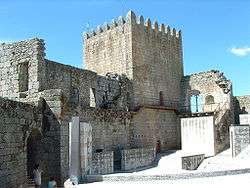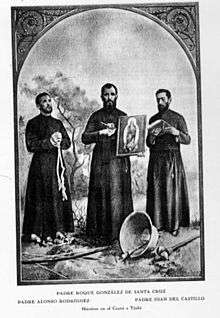Manuel Cabral de Alpoim
| Manuel Cabral de Melo e Alpoim | |
|---|---|
 Castle of Belmonte, belonging to their ancestors | |
| Born |
1589 São Miguel Island, Azores, Portugal |
| Died |
1676 Corrientes, Argentina |
| Buried | Corrientes |
| Religion | Roman Catholic |
| Occupation | Military |
Manuel Cabral de Melo e Alpoim (1589-1676) was a Portuguese nobleman, Regidor and Alcalde of Buenos Aires.[1]
Biography
Manuel was born in São Miguel Island, he arrived at the Rio de la Plata in the company of their parents.[2] His family had lived for five years in the Portuguese colony of Brazil, in which they had taken refuge after the earthquake in the Azores islands, in 1591.[3]
He began his studies in Buenos Aires, to continue his education at Lisbon.[4] In 1613, Alpoim returned to Buenos Aires, and began to work in his father's business.
During 1620s and 1630s, he occupied several state government posts as Alcalde, Regidor and Maestre de Campo.[5] Resident in Corrientes was appointed as Lieutenant Governor of Province in 1625.[6] Alpoim led the crackdown against the rebel Indians, who in 1628, had murdered the Spanish Jesuits among them Roque González de Santa Cruz, cowardly attacked by the cacique Ñezú in reduction of San Nicolás, located across the Uruguay River.[7] Commanding an army of 200 soldiers of Guarani origin, departed from the city of Itatí to Rio Grande do Sul, in support of the Jesuits. The rapid intervention of Alpoim, saved the lives of hundreds of people. Also gave approximately 4.000 cattle for creating stays in the area.[8]
The heart of Roque González de Santa Cruz, burned and pierced with an arrow, was found by Alpoim inside a bag of relics.[9] The heart wrapped in the blanket, was escorted by soldiers of Alpoim to the city of Corrientes.[10]

With large effort was also devoted to livestock, in 1620s, he had obtained permission for the exploitation of "ganado cimarron" (wild cattle and horses).[11] He had a ranch in Monte Grande, and also ran his mother's ranch in Luján.[12]
Alpoim was a man highly respected by the natives of the area, giving permission for raising cattle to the Indians of the Reductions, to feed their families.[13]
In 1637-38, Alpoim participated in expeditions against the rebel Indians, in the region of Calchaquí Valleys. The expeditions were led by General Pedro Dávila Enriquez (1637), and by Mendo de la Cueva (Governor of Buenos Aires in 1638).[14]
Manuel Cabral de Alpoim used some weapons for defense, he had two Arquebus one of flint, and the other of ammunition. Also he possessed an iron spear, and a sword of habit of the Third .[15]
Family and Ancestors
His father was Amador Vaz de Alpoim a wealthy merchant, who had participated in the expedition of the Ciudad de los Césares. His mother Margarita Cabral de Melo was an aristocratic lady, great-granddaughter of Lourenço Anes and Grimaneza Afonso de Melo (all natives of Azores).[16]
Manuel Cabral de Melo was twice married, 1st, to Inés Arias de Mansilla, daughter of Lucía de Espinosa and Francisco Arias de Mansilla (regidor of Corrientes). And to 2dly, to Juana Delgado de Espinosa, daughter of Jerónima de Espinosa and Francisco Delgado de Ledesma (Captain of Corrientes). Alpoim had two daughters Margarita and Gregoria.[17]
His son Juan Cabral de Alpoim y Arias de Mansilla, was a powerful rancher of Corrientes.
In 1612, Alpoim traveled to Lisbon, where the King of Arms handed his Cartório da Nobreza (certificate of nobility).[18] Her family includes among its illustrious ancestors Kings of Portugal of Castile, and France also including the Royal House of England,[19] through Afonso III of Portugal,[20] (grandson of Eleanor of England). Cabral de Melo also was descendant of the same John, King of England through of Álvaro Gonçalves da Maia (ancestor of Beatriz de Noronha, wife of Álvaro Martins Homem).[21]
His maternal ancestors were relatives to Gonçalo Velho Cabral and Pedro Álvares Cabral discoverers of Azores and Brazil.[22]
Manuel Cabral de Alpoim claimed that his father was a descendant of nobles of France.[23]
References
- ↑ Genealogía, Issue 13, Instituto Argentino de Ciencias Genealógicas
- ↑ Matrimonios, bautismos y defunciones de la Catedral de Buenos Aires, 1601-1644, Academia Americana de Genealogía, Jan 1, 2002
- ↑ Hidalguía - Volumen30 - Página 748. Instituto Salazar y Castro.
- ↑ Orígenes de la ganadería en Corrientes: siglos XVI y XVII - Página. Raúl de Labougle.
- ↑ IX Congreso Internacional de Historia de América, byFernando Serrano Mangas
- ↑ Juan de Torres de Vera y Aragón : nueva historia de la fundación de la, By Gustavo Miguel Sorg
- ↑ Misiones Orientales: La Provincia Perdida. Alejandro Larguía.
- ↑ La Reducción Jesuítica de Santos Cosme y Damián: su historia, su economía y su arquitectura, 1633-1797. Rafael Carbonell de Masy, Teresa Blumers, Norberto Levinton.
- ↑ Revista de la Universidad Nacional de Córdoba Volume 39, Issues 3-4. Dirección General de Publicaciones, Universidad Nacional de Córdoba.
- ↑ Boletín de la Academia Nacional de la Historia, Volume 61. Academia Nacional de la Historia.
- ↑ El Interior y su Historia. Junta de Historia de la Provincia de Corrientes.
- ↑ Boletín de la Academia Nacional de la Historia. Academia Nacional de la Historia (Argentina).
- ↑ Buenos Aires: revista de humanidades, Volume 2, Ministerio de Educación de la Provincia de Buenos Aires
- ↑ Lecciones de historiografía de Corrientes, Part 1, Manuel V. Figuerero
- ↑ Lecciones de historiografía de Corrientes - Volumen 1, Manuel V. Figuerero
- ↑ Historia insulana das ilhas a Portugal sugeytas no Oceano Occidental, Antonio CORDEYRO
- ↑ Nobiliario del antiguo virreynato del Río de la Plata. Carlos Calvo.
- ↑ Actas de la XI Reunión Americana de Genealogía, Instituto Padre Sarmiento de Estudios Gallegos (Santiado de Compostela), Galicia
- ↑ Buenos Aires: revista de humanidades - Volumen2 - Página 63. Ministerio de Educación de la Provincia de Buenos Aires.
- ↑ Corrientes: poder y aristocracia. Juan Cruz Jaime.
- ↑ Primer Congreso Internacional de Historia y Genealogía Gallega. Instituto Argentino Gallego de Ciencias Históricas y Genealógicas.
- ↑ Historia de San Juan de Vera de las Siete Corrientes, 1588-1814, Raúl de Labougle
- ↑ Trabajos de investigacion y de tesis.̈, Issue 9, Universidad de Buenos Aires. Instituto de Didáctica